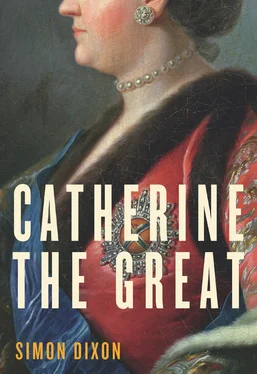First came representatives of Catherine’s non-Russian subjects, headed by twenty-two townsmen from the Baltic lands and Russian Finland, territories conquered from Sweden by Peter the Great in the Great Northern War of 1700–21. Two Englishmen formed part of a seven-strong cohort of foreign-born merchants who had pledged their loyalty to the Russian monarchy: John Tames, a member of the linen manufacturing dynasty whose Dutch founder had been friendly with Tsar Peter, and Martin Butler, joint proprietor of a wallpaper business whose establishment of a privileged manufactory in Moscow in 1751 had provoked British rivals to protest to the Lords Commissioners for Trade. 31Even in their finest attire, such worthies must have cut a sober figure alongside the Zaporozhian and Don Cossack officers who followed them down the Red Staircase bedecked in strident colour. Next came four delegations from Little Russia (Ukraine), and nine German knights from Livland and Estland. Only then did Russians themselves join the procession, led by members of the twelve administrative Colleges established by Peter the Great as Russia’s principal institutions of central government. Seventeen groups of officials culminated in a delegation from the College of Foreign Affairs including the empress’s influential secretary, Grigory Teplov. Behind them followed eight of the twenty-five members of the Senate, Russia’s highest secular court and principal governing body, in the customary order of seniority, juniors first. 32
Once some of Catherine’s closest allies had assumed their places in the procession, bearing the imperial regalia, the appearance at the top of the staircase of Prince Trubetskoy was the signal for the emergence of the empress herself. 33Beneath a silken canopy carried by nine senior officials—another mark of the sacral status of the monarch, adopted from ecclesiastical processions—could be seen the unmistakeable silhouette of the woman who was soon to become the most celebrated monarch in Europe. 34Already statuesque at the age of thirty-three, Catherine had never been blessed with conventional good looks. Admitting that her ‘features were far from being so delicately and exactly formed as to compose what might pretend to regular beauty’, Buckinghamshire was too polite to single out her long, aquiline nose. At least it was compensated by ‘a fine complexion, an animated and intelligent eye, a mouth agreeably turned, and a profusion of glossy chestnut hair’, all of which combined to ‘produce that sort of countenance which, a very few years ago, a man must have been either prejudiced or insensible to have beheld with indifference’. 35The overall effect—a streak of masculinity running through her feminine form—would fascinate her contemporaries for the rest of her life. Catherine did nothing to dispel their puzzlement. Years of isolation at the Court of Empress Elizabeth had taught her never to reveal her innermost thoughts.
* * *
Impassive as the empress seemed as she paused at the top of the Red Staircase, she might have been forgiven a moment of private trepidation. Catherine had first processed across Cathedral Square to commemorate her engagement to Grand Duke Peter shortly after her arrival in Russia in 1744, a ceremony she recalled with distaste. Scarcely less miserable was the memory of the extraordinary occasion in 1753 when Elizabeth had chosen to celebrate the eleventh anniversary of her own coronation by re-staging the ritual in every respect bar the placing of the crown on her head. 36For everyone except the empress, who moved into the Kremlin apartments on the eve of the ceremony, the proceedings proved tiresome in the extreme. Catherine and her husband had to travel in state from the draughty wooden palace on the Yauza River where the Court resided during its visits to Moscow, their servants trotting alongside the carriage for several miles. Neither did matters improve once the ceremony began. As Catherine later recalled:
It was as cold and damp in that church as I had ever felt in my life. I was blue all over and freezing cold in a Court dress open at the neck. The Empress told me to put on a sable stole but I had none with me. She had her own brought to her and took one, wrapping it round her neck. I saw another in her box and thought that she was going to give it to me to put on, but I was wrong. She sent it back. It seemed to me to be rather a clear sign of ill will. 37
After the service, while Elizabeth dined alone in the Kremlin, Peter and Catherine returned to the suburbs in the pouring rain—and in no better a temper than Elizabeth had displayed during the ceremony itself.
More sinister than any temporary discomfort were the wider cultural values represented by the old capital. Catherine instinctively disliked almost everything Moscow stood for. To a monarch obsessed by the value of time, the city merited condemnation as ‘the seat of sloth’. Its very size was an obstacle to efficiency. ‘When there,’ she wrote later, ‘I make it a rule not to send for anyone, since one never finds out until the following day whether the person will come or not and to pay a visit oneself is to waste a whole day in the carriage.’ Nobles lived in Moscow ‘in idleness and luxury’, tended by too many ‘useless domestic servants’, and ‘apart from that, nowhere do people have before their eyes so many symbols of fanaticism, miraculous icons at every step, churches, priests, and convents, side by side with thieves and brigands’. 38Since ‘Moscow’ signified many of the vices that Catherine would seek to extirpate from her Enlightened empire during her thirty-four years on the Russian throne, there was every reason for her to sympathise with the subjugation of the Muscovite past symbolised by her triumphal entry into the city. 39However, since she nevertheless acknowledged the old capital as the repository of a national heritage that she was determined (and committed) to defend, her decision to be crowned there, confirmed within ten days of her accession, suggests that she was equally anxious to mobilise the Kremlin’s sacred historic associations in support of her own precarious regime.
So shaky were the foundations of Catherine’s authority in September 1762 that it was by no means certain that she would reach the first anniversary of her accession. She owed her power to a conspiracy shared with Grigory Orlov and a handful of fellow guards officers, who had deposed her unpopular husband, Peter III, in a bloodless coup accomplished with unexpected ease on the night of 28 June. ‘We have ascended the All Russian throne to the acclamation of the whole people and, as the whole world can attest, the former Emperor has himself willingly renounced the throne in a letter written in his own hand.’ 40This was a hollow boast. Peter was assassinated soon afterwards in circumstances that still remain mysterious and his death left Catherine exposed as both usurper and assassin. Any shred of legitimacy she might possess was vested in her sickly son Paul, still to reach his eighth birthday. As a further complication, Ivan VI, deposed as an infant by Elizabeth in 1741, remained a prisoner in the Schlüsselburg fortress, a few miles east of St Petersburg. Remarking on Russia’s ‘great facility to sudden and dangerous revolutions’, 41many of Europe’s wisest heads predicted that Catherine’s coup would be merely a prelude to another in which she herself must surely be overthrown. Barely a week after seizing the throne, she had already resolved that attack remained the best form of defence. On 7 July, the same day that she issued a risible manifesto proclaiming that her murdered husband had perished from an attack of his haemorrhoids, she announced her intention to stage a coronation, on an unspecified date in September, ‘in the manner of our former Orthodox Monarchs, and of the pious Greeks [the Byzantine emperors], and of the most ancient Kings of the Israelites, who were customarily anointed with Holy oil’. 42
Читать дальше












